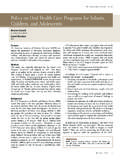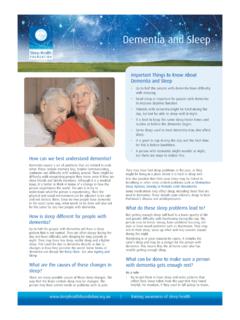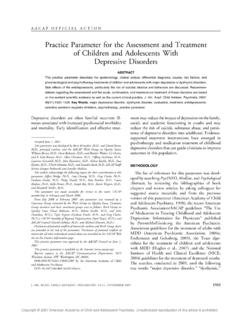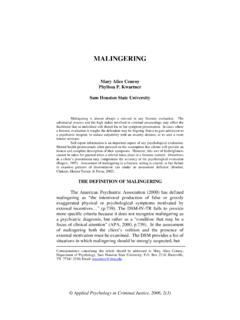Transcription of Policy on Obstructive Sleep Apnea - Pediatric Dentistry
1 96 ORAL HEALTH POLICIES96 696OR6 ALHOEHTAAAAPAICASAOoAuAAAAAncASAniPolicy on Obstructive Sleep ApneaOriginating Council Council on Clinical AffairsAdopted 2016 PurposeThe American Academy of Pediatric Dentistry (AAPD) recog- nizes that Obstructive Sleep Apnea (OSA) occurs in the Pediatric population. Undiagnosed and/or untreated OSA is associated with cardiovascular complications, impaired growth (includ- ing failure to thrive), learning problems, and/or behavioral problems. In order to reduce such complications, AAPD encourages healthcare professionals to routinely screen their patients for increased risk for OSA and to facilitate medical referral when Policy is based on a review of current dental and medical literature pertaining to Obstructive Sleep Apnea including a search with PubMed /MEDLINE using the terms: Sleep Apnea and Dentistry , Obstructive Sleep Apnea and Dentistry , obstruc- tive Sleep Apnea and attention-deficit hyperactivity disorder (ADHD), Sleep disordered breathing; fields: all.
2 Limits: within the last ten years, humans, all children zero to 18 years, English, clinical trials, and literature reviews. The search returned 36 articles. The reviewers agreed upon the inclusion of 15 articles that met the defined criteria. When data did not appear sufficient or were inconclusive, policies were based upon expert and/or consensus opinion by experience re- searchers and OSA is a disorder of breathing characterized by pro- longed, partial upper airway obstruction and or intermittent/complete obstruction ( Obstructive Apnea ) that disrupts normal ventilation during Sleep and normal Sleep OSA affects approximately 18 million people in the United States and is a common form of Sleep -disordered breathing.
3 The con- dition exists in one to five percent of children and can occur at any age, but may be most common in children ages two to Adult criteria for OSA may be used for patients aged 13-18 Early diagnosis and treatment of OSA may decrease morbidity. However, diagnosis frequently is Obstructive Sleep Apnea occurs when the muscles in the back of the throat relax, causing the airway to narrow on inspi- ration. This, in turn, may lower the oxygen level in the blood. This decreased oxygen is sensed by the brain, which then wakes the individual to facilitate breathing. This disruption in breathing may occur multiple times per hour all night Ultimately, these cycles of awakening prohibit the apneic per- son from reaching deep, restful Sleep .
4 For this reason, children with untreated OSA may be inappropriately diagnosed as having OSA differs from central Sleep Apnea . Central Sleep Apnea (CSA) is less common and occurs when the brain fails to transmit signals to the muscles of The most com- mon cause of CSA is congestive heart failure or stroke, high altitude, and medication use; however, premature infants also may be predisposed to Symptoms of OSA include:1 Excessive daytime sleepiness. Loud snoring three or more nights per week. Episodes of breathing cessation witnessed by another person. Abrupt awakenings accompanied by shortness of breath.
5 Awakening with dry mouth or sore throat. Morning headache. Difficulty staying asleep. Attention problems. Mouth breathing. Sweating. Restlessness. Waking up a of untreated Sleep Apnea in school-aged children may include bed wetting and poor school performance due to misdiagnosed ADHD, aggressive behavior, or developmental Rare sequelae of untreated OSA include brain damage, seizures, coma, and cardiac These children also may experience impaired ,2 Etiology of OSAP atients with certain anatomic anomalies, craniofacial anom- alies, neuromuscular diseases, or Down syndrome are at increased risk for development of Obstructive Sleep Anatomic anomalies may include hypertrophic tonsils and ABBREVIATIONS AAPD.
6 American Academy Pediatric Dentistry . ADHD: Attention- deficit hyperactivity disorder. CSA: Central Sleep Apnea . OSA: Obstructive Sleep Apnea . RPE: Rapid maxillary/palatal expansion. AMERICAN ACADEMY OF Pediatric DENTISTRYORAL HEALTH POLICIES 97adenoids, choanal atresia, respiratory tissue thickening ( , caused by disease such as polysaccharidosis, achondroplasia), or Neuromuscular disorders with a component of hypotonia ( , cerebral palsy, myotonic dystrophies. other myopathies) predispose children to Additionally, infants with gastroesophageal reflux disease may be at risk for OSA due to upper airway edema or laryngospasm.
7 Exposure to environmental tobacco smoke also has been associated with Midface deficiency, with or without micrognathia, may predispose some children with craniofacial abnormalities to development of ,2 Certain surgical procedures ( , pharyngeal flaps to correct velopharyngeal insufficiency) in these patients also may contribute to of OSAP ediatric dentists are in a unique position to be able to iden- tify patients at greatest risk. Adenotonsillar hypertrophy6 and obesity are major risk factors for OSA in otherwise healthy children. With a history and careful clinical examination at each dental visit, Pediatric dentists may identify signs and symptoms that may raise a concern for OSA.
8 Assessment of tonsillar hypertrophy6 and percentage of airway obstruction by the Friedman Tongue Classification system7 may be done as part of the routine intraoral screening tools are available for adult Sleep Apnea ( , STOP-BANG questionnaire8, Kushida Index9). How- ever, inclusion of Sleep questions on the health history form may further help identify patients at risk. Such questions might include: Does your child snore loudly when sleeping? Does your child have trouble breathing while sleeping? Does your child stop breathing during Sleep ? Does your child occasionally wet the bed at night? Is your child hard to wake up in the morning?
9 Does your child complain of headaches in the morning? Does your child tend to breathe through his/her mouth during the day? Have you or the teacher commented your child ap- pears sleepy during the day? Does your child fall asleep quickly?If a patient is suspected of being at risk for OSA, a referral to the appropriate medical doctors ( , otolaryngologist, pulmonologist, Sleep medicine physician) is advised. Then, a clinical examination in addition to polysomnography ( Sleep study) will either confirm or deny the The Amer- ican Academy of Pediatrics recommends polysomnography be performed in children/adolescents with snoring and signs/symptoms of A positive diagnosis of OSA likely will be made by a Sleep physician in the presence of signs/symptoms concurrent with at least one predominantly Obstructive re- spiratory event, mixed Apnea .
10 Or hypopnea per hour of Sleep or a pattern of Obstructive hypoventilation with hypercapnia for at least 25 percent of total Sleep time during the poly- of OSAT reatment for OSA may be accomplished with either non- surgical or surgical options, depending on its severity and etiology. Non-surgical options include treatment of nasal allergies1, continuous positive airway pressure (CPAP), weight reduction, and changes in Sleep hygiene. Previously, three types of oral appliances commonly were used for treatment of Sleep -related breathing: mandibular advancing devices, tongue retaining devices, and palatal lift Although some studies have advocated the use of non-surgical interventions such as rapid maxillary/palatal expansion (RPE) or a modified monobloc appliance,2,12 these studies had small sample As functional intraoral appliances alter the position and/or growth of the maxilla or mandible, a complete orthodontic assessment including records should be completed.















